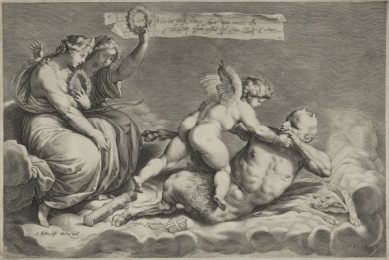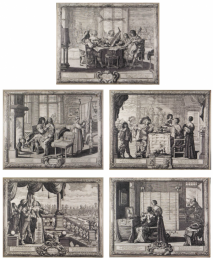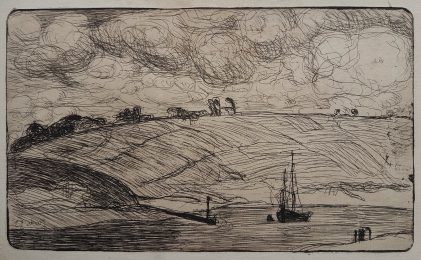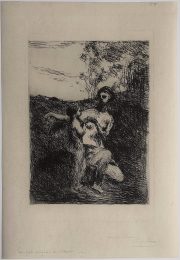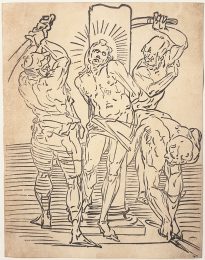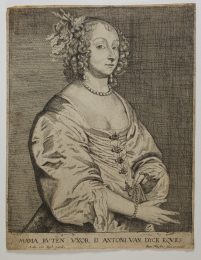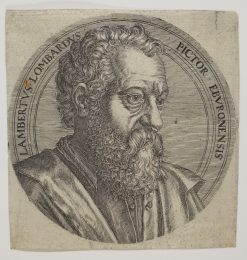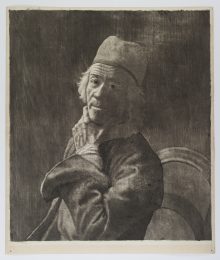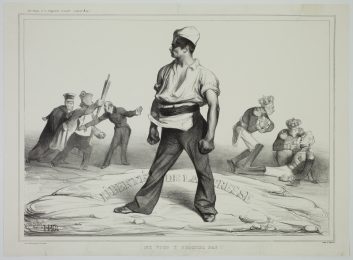Details — Click to read
René BOYVIN (or workshop of): Silenus with two Satyrs, after Luca Penni
Engraving, 240 x 168 mm (to the borderline). Robert-Dumesnil 28, LeBlanc 37, IFF p. 171, Levron 177, Albricci 7.
Fine impression printed on watermarked laid paper (watermark: grapes, 39 x 22 mm).
Generally in good condition. A horizontal fold slightly rubbed at lower left, a tiny 2 mm loss of paper on the borderline upper center, a tiny area of paper thinning at upper on the back of the sheet. Old writing in pen and ink bottom on verso. Thread margins at bottom and right, trimmed on the borderline at top and left (sheet: 244 x 172 mm).
Rare.
Silenus with two satyrs is mentioned in 1568 by Giorgio Vasari in the second edition of his Lives of the Most Excellent Painters, Sculptors, and Architects: “E Luca Penni ha mandato fuori due satiri, che danno bere ava Baccho” “Luca Penni released two satyrs who are giving Bacchus a drink […]” (Cordellier, p. 100). Dominique Cordellier notes that, contrary to what has been said, Vasari does not say that Penni engraved the print himself, but rather, that he published it. Luca Penni’s activity as a publisher could explain the very high number of prints made after his drawings, as well as copperplates, in the inventory after his death.
Robert-Dumesnil, as many other art historians have done, attributes this engraving to René Boyvin. Jacques Levron, as for him, makes a distinction between two series of prints in René Boyvin’s œuvre: those with a signature, either a full name or a monogram, and those that are not signed or have another name. The Silenus bearing only the name of Luca Penni is thus grouped together with the “estampes de l’atelier” (“prints from the workshop”); Levron mentions however that some of these are undoubtedly by Boyvin, while others are by one of his students or other printmakers, such as Pierre Milan. The Silenus is among the works that Levron chose to have as illustrations in his catalogue, which would indicate it belongs in the first category.
Gioconda Albricci indicates sources for the Silenus: “this print is partly derived from a detail in Giulio Romano’s The Wedding of Psyche in the Palazzo del Te: however, the origin of this subject is to be found in classical sculpture: see for example, for the central figure, the satyr called the Barberini Faun (Munich, Antikensammlungen). The subject was also engraved by Delaune (R.D. IX, p. 38, no. 39).” (Albricci, p. 90, our translation)
References: Alexandre-Pierre-François Robert-Dumesnil: Le peintre-graveur français, vol. 8, 1850; Jacques Levron: René Boyvin, graveur angevin du XVIe siècle : avec le catalogue de son œuvre et la reproduction de 114 estampes, 1941; Gioconda Albricci, “Luca Penni e i suoi incisori”, in Rassegna di Studi e di Notizie, vol. X, anno IX, 1982; Dominique Cordellier: Luca Penni. Un disciple de Raphaël à Fontainebleau, 2012.











